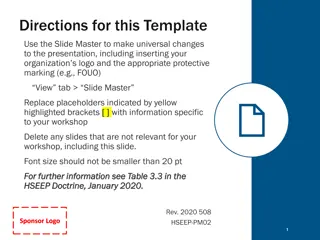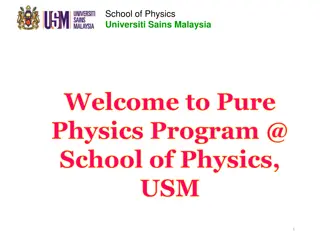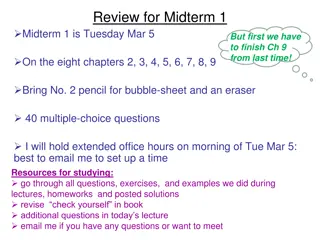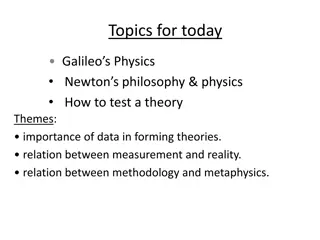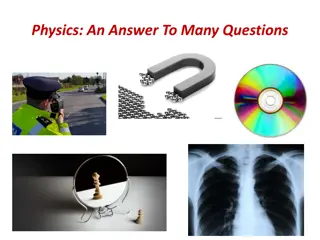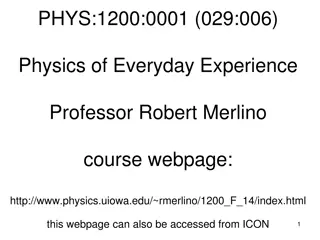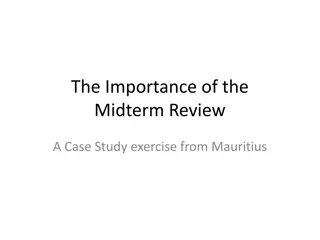Physics Midterm 1 Review Guide
Overview of important topics for Physics Midterm 1 including Newton's laws, linear motion, momentum, energy, and rotation. Provides key concepts to review, resources for studying, and example questions. Includes explanations on topics like inertia, forces, acceleration, energy conservation, and more to help prepare for the exam.
Download Presentation

Please find below an Image/Link to download the presentation.
The content on the website is provided AS IS for your information and personal use only. It may not be sold, licensed, or shared on other websites without obtaining consent from the author.If you encounter any issues during the download, it is possible that the publisher has removed the file from their server.
You are allowed to download the files provided on this website for personal or commercial use, subject to the condition that they are used lawfully. All files are the property of their respective owners.
The content on the website is provided AS IS for your information and personal use only. It may not be sold, licensed, or shared on other websites without obtaining consent from the author.
E N D
Presentation Transcript
Review for Midterm 1 Midterm 1 is Friday October 9 On the seven chapters 2, 3, 4, 5, 6, 7, 8 Bring No. 2 pencil for bubble-sheet and an eraser 45 multiple-choice questions Resources for studying: go through all questions, exercises, and examples we did during lectures, homeworks and posted solutions with multiple-choice questions know confidently why the wrong answers are wrong revise check yourself questions in book additional questions in today s lecture email me if you have any questions
Recall Chapter 2: Newton s 1st law, inertia, forces, e.g. gravitational (=weight), support force, equilibrium (sum of forces = 0) Chapter 3: Linear motion, speed (= distance/time), velocity (= speed with direction), acceleration(= rate of change of velocity), free-fall motion (a = g, speed gains/loses g m/s every second if falling/rising) Chapter 4: N s 2nd law, Fnet = ma, weight = mg, weight vs mass, friction, non- free fall and air resistance, terminal velocity Chapter 5: N s 3rd law, action-reaction, vectors ( only at conceptual level) Chapter 6: Momentum(= mv), Impulse=F t = change in momentum, external vs internal forces, momentum conservation when Fnet on system =0, collisions Chapter 7: Energy, Kinetic energy = m v2, Potential energy, Grav. PE = mgh, Work = F d, mechanical energy, change in mech. energy = Work, Power = Work/time, Total energy conservation, machines Chapter 8: Rotation, linear/tangential speed vs angular/rotational speed, v = r , rotational inertia I, torque = F x lever arm, angular momentum = I , ang mom conservation, CM/CG, stability
When in a subway car that suddenly stops, you lurch forward. What s the best explanation for this? A)Because of Newton s 1st law you have inertia. B) Because you have no acceleration C) Because of action-reaction forces between the car and you D) Because of the support force
When in a subway car that suddenly stops, you lurch forward. Whats the best explanation for this? A) Because of Newton s 1st law you have inertia. B) Because you have no acceleration C) Because of action-reaction forces between the car and you D) Because of the support force Answer A: Newton s 1st law says that objects (you) tend to keep moving in a straight line; inertia resists changes in motion
According to Newton's law of inertia, a rail road train in motion should continue going forever even if its engine is turned off. We never observe this because railroad trains A) move too slowly. B) must go up and down hills. C) are much too heavy. D) always have forces that oppose their motion
According to Newton's law of inertia, a rail road train in motion should continue going forever even if its engine is turned off. We never observe this because railroad trains A) move too slowly. B) must go up and down hills. C) are much too heavy. D) always have forces that oppose their motion Answer: D How about if there was no friction and no air drag then what would happen once the engine is turned off? Then the train would be accelerating while the engine was on, and would stop accelerating once the engine is turned off i.e would move at constant velocity.
A hockey puck is set in motion across a frozen pond. If ice friction and air resistance are neglected, the force required to keep the puck sliding at constant velocity is A)equal to the product of its mass times its weight. B) equal to its weight divided by its mass. C) zero. D) equal to its weight
A hockey puck is set in motion across a frozen pond. If ice friction and air resistance are neglected, the force required to keep the puck sliding at constant velocity is A) equal to the product of its mass times its weight. B) equal to its weight divided by its mass. C) zero. D) equal to its weight Answer: C, since no acceleration so no net force
As youre sitting in your chair, your weight acts as a downward force on the chair. Why then does the chair not sink into the ground? A) B) from the ground it is pushing down on C) because of inertia the resistance to changes in motion. D) because of momentum conservation. because of its weight because it feels an upward directed support force
As youre sitting in your chair, your weight acts as a downward force on the chair. Why then does the chair not sink into the ground? A) B) is pushing down on C) because of inertia the resistance to changes in motion. D) because of momentum conservation. because of its weight because it feels an upward directed support force from the ground it Answer: B, the chair is in equilibrium, there is zero net force on it. The gravitational force is equal and opposite to the upward support force.
A skier covers a distance of 3 m in half a second. What is his average speed? A) 1.5 m/s B) 3 m/s C) 6 m/s D) 9 m/s
A skier covers a distance of 3 m in half a second. What is his average speed? A) 1.5 m/s B) 3 m/s C) 6 m/s D) 9 m/s C) Average speed =distance/time = 3m/0.5s = 6 m/s
As an object freely falls downward, its A)velocity increases B) acceleration increases. C) both of these D) none of these.
As an object freely falls downward, its A) velocity increases B) acceleration increases. C) both of these D) none of these. A)It accelerates at either (i) a constant rate =g, if there is negligible air resistance or (ii) gradually less acceleration if there is air resistance.
When a rock thrown upwards falls back down and passes the same point it was thrown from, a) its velocity is zero and its acceleration is zero b) its velocity is zero and its acceleration is about 10 meters per second per second c) its velocity is about 10 m/s and its acceleration is zero d) its velocity is negative of the initial velocity it was thrown up with and its acceleration is about 10 meters per second per second.
When a rock thrown upwards falls back down and passes the same point it was thrown from, a) its velocity is zero and its acceleration is zero b) its velocity is zero and its acceleration is about 10 meters per second per second c) its velocity is about 10 m/s and its acceleration is zero d) its velocity is negative of the initial velocity it was thrown up with and its acceleration is about 10 meters per second per second. Answer d) Note, acc. in free-fall (on earth) is always g~10 m/s2
Half a second after starting from rest, a free-falling object will have a speed of about a) 10 m/s b) 20 m/s c) 5 m/s d) 0 e) None of these
Half a second after starting from rest, a free-falling object will have a speed of about a) 10 m/s b) 20 m/s c) 5 m/s d) 0 e) None of these Answer c) In free fall, object gains about 10m/s every second. So, in half a second, gain 5 m/s. What is it s acceleration at that time? a = g = 10 m/s2 downwards, always for free-fall What if the free-falling object is moving upward at a speed of 20 m/s. What is its speed half a second later? 15 m/s since it loses 10m/s every second
Two balls are thrown from the same point high on a cliff. One is thrown upwards and the other is merely dropped from rest. Neglecting air resistance, which has the higher acceleration? A)The ball thrown upwards B)The ball dropped from rest C) It depends on how fast the thrown ball was thrown D) It s the same for each E)None of these
Two balls are thrown from the same point high on a cliff. One is thrown upwards and the other is merely dropped from rest. Neglecting air resistance, which has the higher acceleration? A) The ball thrown upwards B) The ball dropped from rest C) It depends on how fast the thrown ball was thrown D) It s the same for each E) None of these Answer: D, acceleration = g downwards
If a projectile is fired straight up at a speed of 10 m/s, the total time to return to its starting position is about A) 2 seconds. B) 10 seconds. C) 20 seconds. D) 1 second. E) not enough information to estimate
If a projectile is fired straight up at a speed of 10 m/s, the total time to return to its starting position is about A) 2 seconds. B) 10 seconds. C) 20 seconds. D) 1 second. E) not enough information to estimate Answer: A Each second it loses about 10m/s so after 1s, it has zero velocity, i.e. is turning around. Then it gains 10m/s as it falls, so after another second (a total of 2 s) it has -10m/s i.e. same initial speed at which it began, hence returned to the same point. So, if you re told an object thrown directly upwards from the ground spends 2s in the air before returning to ground (= it s hang-time ), then you know the speed it was initially kicked up with was 10 m/s.
A rock weighs 30 N on Earth. A second rock weighs 30 N on the moon. Which of the two rocks has the greater mass? A) the one on the moon B) the one on Earth C) They have the same mass. D) not enough information to say
A rock weighs 30 N on Earth. A second rock weighs 30 N on the moon. Which of the two rocks has the greater mass? A) the one on the moon B) the one on Earth C) They have the same mass. D) not enough information to say A) Because weight =mg, and g least on moon, so m must be bigger to get the same weight of 30N
A 20-kg girl and her 40-kg big brother are each sitting on a sled, waiting to be pushed across the snow. To provide them with equal horizontal acceleration, we would have to push with A) B) C) D) E) equal forces twice as much force on the boy twice as much force on the girl four times as much force on the boy none of these
A 20-kg girl and her 40-kg big brother are each sitting on a sled, waiting to be pushed across the snow. To provide them with equal horizontal acceleration, we would have to push with A) B) C) D) E) equal forces twice as much force on the boy twice as much force on the girl four times as much force on the boy none of these Answer: B Since a = Fnet/m, an object with twice the mass requires twice the force in order to experience the same acceleration.
A girl pulls on a 10-kg wagon with a constant horizontal force of 20 N. If there are no other horizontal forces, what is the wagon's acceleration in meters per second per second? A) 2.0 B) 0.5 C) 20 D) 200 E) None of the above
A girl pulls on a 10-kg wagon with a constant horizontal force of 20 N. If there are no other horizontal forces, what is the wagon's acceleration in meters per second per second? A) 2.0 B) 0.5 C) 20 D) 200 E) None of the above Answer: A, since a = F/m = 20/10 = 2 m/s2 What if there was a friction force of 5 N? Then a = F/m = (20-5)/10 = 1.5 m/s2
What horizontally-applied force will accelerate a 200-kg box at 1 m/s2 across a floor against a friction force of 400N? a) 200 N b) 400 N c) 600 N d) 2400 N e) None of these
What horizontally-applied force will accelerate a 200-kg box at 1 m/s2 across a floor against a friction force of 400N? a) 200 N b) 400 N c) 600 N d) 2400 N e) None of these C) Fnet = Fapplied friction = ma So, Fapplied = ma + friction = 200 + 400 = 600 N
Several balls of different masses are dropped from the 15th floor of the North Building. Neglecting air resistance, the quantity that has the same value for each ball A) energy B) acceleration C) momentum D) force exerted upon striking the ground E) All of the above
Several balls of different masses are dropped from the 15th floor of the North Building. Neglecting air resistance, the quantity that has the same value for each ball A) energy B) acceleration C) momentum D) force exerted upon striking the ground E) All of the above Answer: B In free-fall all objects fall at the same rate, a = g. The velocity will also be the same for all balls, but the momentum will not, since momentum = mv and mass is different for each ball. Also their energies are different because their mass is different, and the force exerted upon striking the ground will also be different because of this.
A large person and a small person wish to parachute at equal terminal velocities. The larger person will have to a) Jump first from the plane b) Pull upward on the supporting strands to decrease the downward net force c) Jump lightly d) Get a larger parachute e) Get a smaller parachute
A large person and a small person wish to parachute at equal terminal velocities. The larger person will have to a) Jump first from the plane b) Pull upward on the supporting strands to decrease the downward net force c) Jump lightly d) Get a larger parachute e) Get a smaller parachute d) If he does nothing, the larger person would accelerate for longer and have a larger terminal velocity. So he needs to do something to decrease this and effectively increase air resistance i.e. get larger parachute.
Consider a large cannonball and a small ping-pong ball, each being dropped from the same point on a tree. Which experiences the greater air resistance force as it falls? A)The ping-pong ball B)The cannonball C)The same on each
Consider a large cannonball and a small ping-pong ball, each being dropped from the same point on a tree. Which experiences the greater air resistance force as it falls? A) The ping-pong ball B) The cannonball C) The same on each Answer: B Air resistance force is greater for greater speeds and for greater sizes. Cannonball has greater size, and also has greater speed (Remember to distinguish btn force and its effect -- acceleration) See also detailed explanation in Lecture 3 questions about elephant vs feather, and iron ball vs wooden ball
A player catches a ball. Consider the action force to be the impact of the ball against the player s glove. The reaction to this force is a) player s grip on the glove b) Force the glove exerts on the ball c) Friction of ground against player s shoes d) Muscular effort in the player s arms e) None of these
A player catches a ball. Consider the action force to be the impact of the ball against the player s glove. The reaction to this force is a) player s grip on the glove b) Force the glove exerts on the ball c) Friction of ground against player s shoes d) Muscular effort in the player s arms e) None of these Answer: b) Force of object 1 on object 2 = -(Force of object 2 on object 1) these two forces make action-reaction pair
As a 1-kg ball falls, the action force is the 10-N pull of the Earth s mass on the ball. The reaction force is A) air resistance acting against the ball, but less than 10N B) acceleration of the ball C) pull of the ball s mass on the earth, but less than 10-N D) pull of the ball s mass on the earth, equal to 10-N E) None of these
As a 1-kg ball falls, the action force is the 10-N pull of the Earths mass on the ball. The reaction force is A) air resistance acting against the ball, but less than 10N B) acceleration of the ball C) pull of the ball s mass on the earth, but less than 10-N D) pull of the ball s mass on the earth, equal to 10-N E) None of these Answer: D Every force can be thought of as part of an action- reaction pair: Force that object I exerts on object II is equal and opposite to the force that II exerts on I. So here the reaction force is the gravitational pull on Earth exerted by the ball, and it is 10-N upwards.
A wooden sphere and an iron sphere of the same size and shape are dropped simultaneously from a table and happen to reach the ground at the same time. The iron sphere has a greater A) momentum. B) acceleration. C) speed. D) all of these E) none of these
A wooden sphere and an iron sphere of the same size and shape are dropped simultaneously from a table and happen to reach the ground at the same time. The iron sphere has a greater A) momentum. B) acceleration. C) speed. D) all of these E) none of these Answer: A If they re dropped at the same time and reach the ground at the same time, then they must have had the same speed and acceleration (air resistance was negligible or similar on both during the relatively short fall). The iron ball will have more momentum as its mass is larger.
An automobile and a baby carriage traveling at the same speed collide head-on. The impact force is A) greater on the baby carriage. B) greater on the automobile. C) the same for both.
An automobile and a baby carriage traveling at the same speed collide head-on. The impact force is A) greater on the baby carriage. B) greater on the automobile. C) the same for both. c) The same for both action/reaction (Similarly, same momentum change for both)
Padded dashboards in cars are safer in an accident than nonpadded ones because an occupant hitting the dash has A)increased momentum. B) increased time of impact. C) decreased impulse. D) decreased time of impact.
Padded dashboards in cars are safer in an accident than nonpadded ones because an occupant hitting the dash has A) increased momentum. B) increased time of impact. C) decreased impulse. D) decreased time of impact. Answer: B, same change of momentum to final zero, but done over a longer time means the force is less.
When two objects collide, A) their total momentum is always conserved B) their total energy is always conserved C) their total energy and momentum are sometimes conserved D) their total energy and momentum are always conserved unless heat is generated E) more than one of the above is true F) none of the above is true
When two objects collide, A) their total momentum is always conserved B) their total energy is always conserved C) their total energy and momentum are sometimes conserved D) their total energy and momentum are always conserved unless heat is generated E) more than one of the above is true F) none of the above is true Answer: A Energy is conserved only sometimes, when the collision is elastic.
A 2-kg chunk of putty moving at 2 m/s collides with and sticks to a 6-kg bowling ball initially at rest. The bowling ball and putty then move with a speed of a) 0 b) 0.5 m/s c) 1 m/s d) 2 m/s e) More than 2 m/s
A 2-kg chunk of putty moving at 2 m/s collides with and sticks to a 6- kg bowling ball initially at rest. The bowling ball and putty then move with a speed of a) 0 b) 0.5 m/s c) 1 m/s d) 2 m/s e) More than 2 m/s b) Momentum before = momentum after (2kg)(2m/s) +0 = ((2+6)kg) v So v=4/8 = 0.5 m/s




